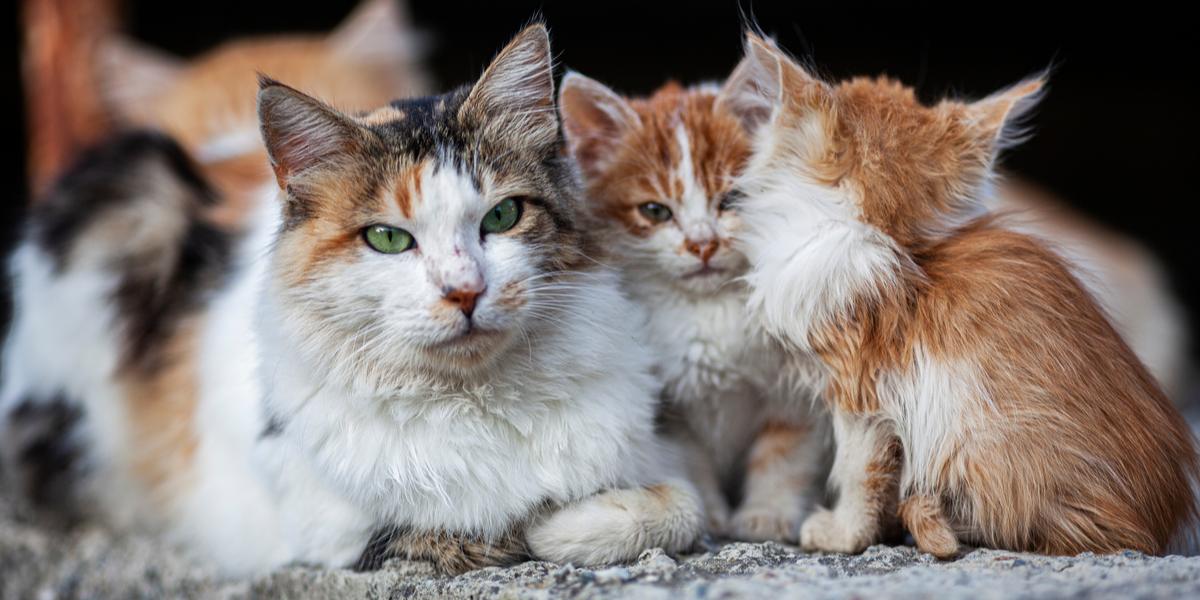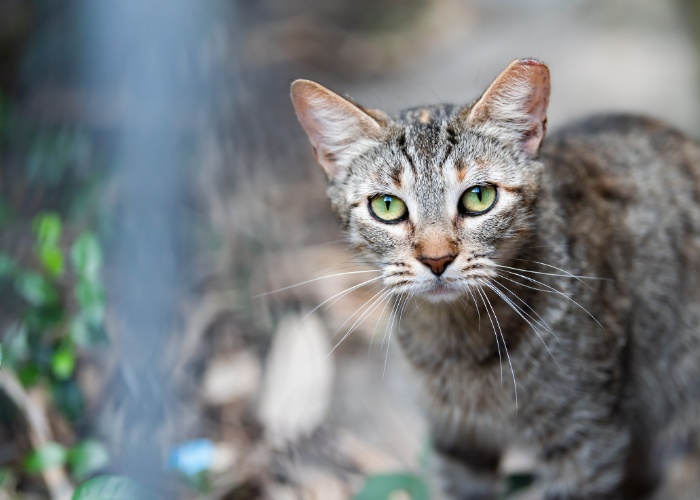
While elusive and hard to count, there are at least 32 million feral cats living in the United States. Most of these unsocialized felines live in urban colonies, but they’re also common in suburban and rural neighborhoods.
The feral cat population is increasing exponentially, but they’re not the only cats living outside and surviving on their own. The tabby you see in the grocery store parking lot might be feral, but it might also be a stray.
Feral and stray are not the same, even though the words are often used interchangeably. There are distinct differences that separate these two kinds of community cats. If you want to advocate for the cats in your area, the first step is knowing the difference.
Identifying a feral versus a stray, however, isn’t always easy.
Feral Cat vs Stray Cat & The Other Kinds of Cats

Before you work on identification, it’s important to understand the different terms used to describe the different kinds of cats based on their living conditions and socialization history. Living condition relates to whether the cat lives inside or outside, and socialization is all about how comfortable the cat is with humans.
Feral Cat
A feral cat is a cat that lives 100% outside (except if they’ve found an abandoned building with easy access) and has no owner. Ferals are not socialized to people and act more like wild animals than domesticated pets.
These are the cats that either hiss when a human gets too close or, more often, run away. They often live in communities with several other feral cats. Sometimes they rely on kind humans to leave them food, but many colonies are capable of working together to take care of themselves.
Also Read: 15 Facts You Should Know About Feral Cats
Stray Cat
Strays also live outside, but the main difference from feral cats is their level of socialization. Unlike feral cats, strays have some kind of history with humans. Stray cats were pets at one point in their lives and were either abandoned by their families or lost.
The more time a stray spends outside without human contact, the more likely they are to gradually become feral. But before that happens, strays are usually friendly toward humans and might approach strangers looking for food or attention.
Some strays are still shy, however, and prefer to stay hidden. Unlike a feral cat, a stray has the potential to be adopted and become someone’s pet. The best-case scenario would be for a lost stray cat to be reunited with its original family.
Community Cat
The term “community cat” is often used by animal advocates to refer to both strays and feral cats. The phrase is used as an umbrella to cover all unowned cats that live outside in a particular community.
Pet Cat
A pet cat is a cat that has a designated owner. Hopefully, that owner provides for all the cat’s basic needs including food, water, shelter, and socialization. Be careful when identifying outdoor cats, however. Some pet cats live outside and don’t feel restricted by things like fences or property lines. An outside pet cat can sometimes be confused for a stray.
Identifying A Feral Cat Versus A Stray Cat

We all know that cats come in different breeds and colors, and there are dozens of different coat patterns. You can’t, however, discern a feral, stray, or even a pet based on their appearance alone. Identifying whether a cat is feral or stray will require observation and specific knowledge about feline behavior.
Here are a few tips…
Socialization Feral and Stray Cats With Humans And Other Cats
As the main difference between a feral cat and a stray cat, the first thing to do is observe the cat’s behavior and gauge socialization. If the cat approaches you, your car, your house, or anywhere with people, it is a stray or pet.
A feral will always keep their distance from people. An exception occurs when a colony is maintained by a human caretaker. In these cases, the colony cats might become familiar with the person who regularly leaves them food. Familiar is not the same, however, as friendly.
You can also make assumptions based on how the cat interacts with other cats. Most feral cats belong to colonies. These groups of cats can consist of just a few or dozens. They eat and live together. A stray cat, however, will likely be on their own. Some stray cats are abandoned at feral colonies, but feral cats rarely accept a new stray into their midst.
When You See Them
All cats are crepuscular, which means they are most active at dawn and dusk. Pet cats and strays, however, often adjust their schedules (at least partly) to better coincide with when humans are out and about. Feral cats do no such thing. If you see a cat out in the middle of the day, it’s most likely stray. Feral cats tend to hide and sleep during the day and come out when the sun sets.
Nursing Moms And Unaltered Males
According to reports, only about 2% of feral cats are spayed or neutered. TNR (trap, neuter, and release) programs are expanding, but it’s difficult to bring feral cats in for necessary sterilization.
For this reason, if the cat you see is pregnant, a nursing mother, or an unaltered male, it is likely feral. It might also be feral if it has an ear tip. This is when a small portion of the ear is cut during surgery to help caretakers identify cats that have already been spayed or neutered.
Vocalizations
Pets and strays often meow to humans as a form of communication. A meow might mean “feed me” or “scratch my chin.” A stray cat might also purr. A feral cat might hiss if you get too close, but it won’t give you a friendly meow.
Also Read: 7 Common Cat Vocalizations And What They Mean
Body Language
You can tell a lot about a cat’s history by the way it moves. A stray cat might be shy or scared, but it will still walk around and behave as you would expect a pet to behave. Their tail will likely be up in the air, it might rub against a tree or fence post, and it might make eye contact.
Also Read: What Your Cat’s Tail Can Tell You
A feral cat will be more cautious and protective. Their tail will likely be wrapped around their body and they might crawl or crouch instead of walk upright near you.
If you’ve already trapped the cat, you’ll need to wait a few days to get an accurate gauge of their body language. Any cat, feral, stray, or pet, will act scared and even aggressive in an unfamiliar environment. Most strays will relax after a few hours or days, but a feral will stay on guard and lash out if you try to touch them.
How to Tell if a Cat Is Feral or Stray Based on Appearance

You can’t tell a stray cat from a feral by their physical appearance alone, but it can provide a few hints. Strays, for example, are usually not used to living outdoors. They might be obviously dirty and skinny. A feral is used to living outside and will likely have a well-groomed coat.
What To Do Next
Once you’ve made an educated guess about whether the cat you’ve found is feral or stray, you can take the next steps in providing them with help. Because adult feral cats are not candidates for adoption, they are often euthanized in shelters. In these cases, it is in the cat’s best interest to stay where they are.
You can, however, help prevent overpopulation by contacting a TNR program to ensure the cat and its fellows are responsibly sterilized. You could also become a colony caregiver to ensure the feral cats are fed and potentially provide emergency veterinary care.
If there are kittens in the colony, they might be candidates for socialization and eventual adoption. Contact a local animal shelter for assistance.
If you find a stray cat, the best thing to do is bring them in and either care for them yourself or take them to a shelter. Hopefully, the cat will have a microchip to connect them to their family. You can bring them to any vet’s office or shelter to have them scanned for a chip.
If a microchip doesn’t reunite the cat with a family, a shelter will give them the help they need.







